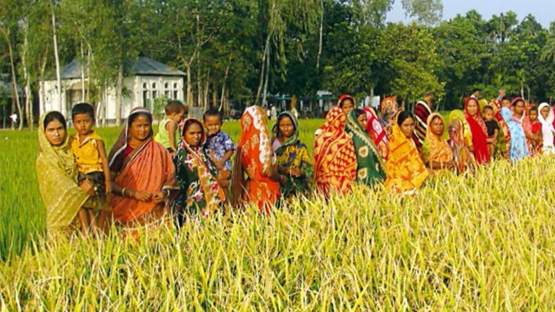In Bangladesh, villagers have often faced “monga” periods, a seasonal famine when food is scarce and prices of whatever food is available are high. Today, thanks to a crop breeding programme that takes the calendar as well as the soil and climatic conditions into consideration, many villages in the country’s northern region no longer struggle during the long monga periods. Farmers can now plant and harvest new crop varieties with synced maturation and growing seasons, allowing them to use their fields for more than just rice. Developed by the Bangladesh Institute of Nuclear Agriculture (BINA) and with support of the Joint FAO/IAEA Division, the breeding programme of course included rice, the major crop, but also groundnuts, mung beans and lentils. The positive socio-economic impact of being able to plant a diversity of crops helps sustain local agricultural production and food security but also represents billions of US dollars added to the national economy.
As researchers worked on developing new crop varieties for the farmers of Bangladesh, they kept an eye on the calendar. If they could develop a rice variety that would mature faster than the conventional rice currently being used, then farmers could use the extra days of the growing season to plant other crops and vegetables. And that’s just what they did.
Conventional rice takes around 140 to 150 days to ripen, but the Binadhan-7 mutant variety, developed by BINA in 2007 with support of the Joint Division and the IAEA’s technical cooperation programme matures in 110 to 120 days. That means farmers have 20 or more extra days to plant other crops to carry them through the monga periods, foods that can also improve family nutrition, such as winter vegetables, pulses and oil seeds. In a 10-year period, Bangladesh increased its enormous annual rice harvest from 26.8 million tonnes in 2003–2004 to 33.8 million tonnes in 2012–2013. Now, with the shortened maturation season, the farmers can plant the newly developed crops that not only are adapted for the local climate, they have inbred resistance to the new pests and pathogens emerging with the changing climate, and they can be planted and mature after the rice is harvested.
Bangladesh is one of the world’s most successful countries in terms of mutation breeding. The Joint Division has supported it all along the process and continues training scientists from BINA on specific screening techniques developed at the Joint Division’s laboratory. BINA has had its own irradiating equipment and laboratory since the 1970s. Of the 64 improved mutant varieties it has developed since it began doing its own mutation breeding, 58 were developed using nuclear technology. Fourteen of those improved varieties have been introduced since 2012.





